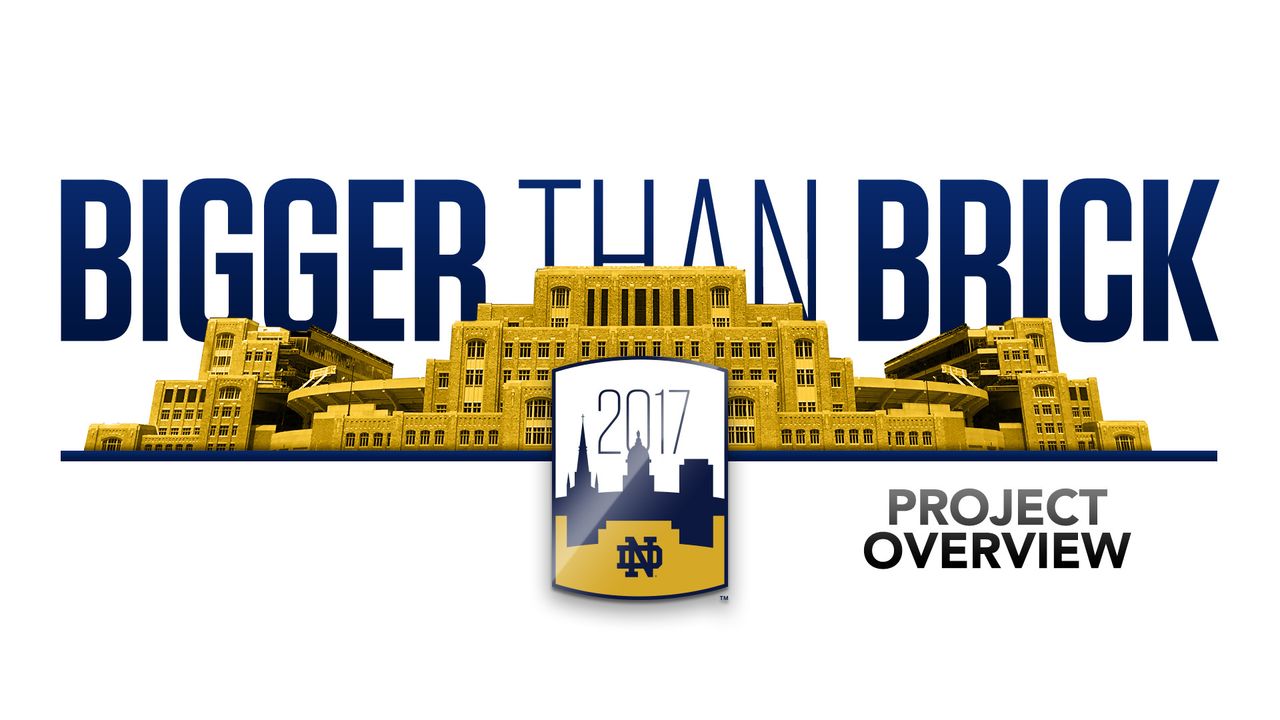July 17, 2017
Throughout the 2017 football season we will be giving you a behind the scenes look at the Campus Crossroads Project on social media – you can follow along with the #NDBiggerThanBrick hashtag. Why #NDBiggerThanBrick? Back in Notre Dame’s 1930 Alumnus magazine, it was stated “Notre Dame is bigger than brick and far more than mortar.”
When Knute Rockne-designed Notre Dame Stadium opened for business in the autumn of 1930, it was described as “a monument to sportsmanship, a tribute to fighting youth, and an amphitheater devoted to modern athletics.”
Eighty-seven years later, the newest version of the University of Notre Dame’s home for football qualifies as all that and a whole lot more.
Long considered one of the most iconic athletic facilities in the world, Notre Dame Stadium in 2017 takes on a new role–not only as a centerpiece of the University’s campus and physical plant but also as one of the most effective combinations and commitments to athletics, academics and student life anywhere in major college sports. The stadium location now becomes a day-to-day destination for University students, faculty and staff–representing a perfect melding of old and new.
“The towering spire of the Church (the Basilica of the Sacred Heart) above the new wall, high as it is, carries with the cross at its top the higher purpose of Notre Dame to the surrounding campus. The golden Dome, surmounted by the figure of Our Lady, loses nothing through the . . . new structure, but rather seems to include it in the embracing gesture of the holy hands. . . . No one can come to the new Stadium without absorbing . . . this other, this deeper, Notre Dame.”
That quotation came from an editorial in the October 1930 Notre Dame Alumnus magazine–yet it couldn’t be more true today.
For nine decades Notre Dame Stadium has been home to national championship football teams, Heisman Trophy winners and All-Americans–and, in recent years, to the University’s Commencement ceremony. Exactly 20 years ago, in 1997, it added 20,000 new seats to its resume. Now, in 2017, the stadium location now includes three new structures on the east, west and south sides, as well as extensive renovations on the north end and major game day improvements for fans throughout the venue.
Those upgrades include new wider seats in the lower bowl, upgraded concession and restroom facilities, a 1930s art deco look to the main concourse, nearly 150 television monitors in the concourses, new displays at Gate C honoring Irish football award winners, improved Wi-Fi and connectivity, plus a new video board at the south end of the stadium. The khaki-colored bricks of Notre Dame Stadium remain a familiar sight. But what’s inside those new bricks walls has undergone extensive and substantial changes since the construction and remodeling project began three years ago.
Duncan Student Center on the west side includes :
- Hagerty Family Café, Midfield Commons, Innovation Lounge and several other new restaurants on the first floor
- Thomas and Therese Grojean Family Loft Family Loft, a student media center and climbing wall on the second floor
- The Smith Center for Recreational Sports on the third and fourth level
- The 1842 Club on what is termed level 5.5
- Dahnke Ballroom on the seventh level, plus a new broadcast position for NBC Sports
- Rasmus Family Club on level eight
- Various football game management and University hospitality booths on the ninth floor
Corbett Family Hall on the east side includes:
- The Rex and Alice A. Martin Media Center and Notre Dame Studios on the first floor
- Department of Anthropology facilities on the second floor
- Department of Psychology offices and classrooms on the third, fourth and fifth levels
- Downes Club hospitality space on the seventh and eighth floors
- A press box and radio booths that opened in 2016, as well as additional hospitality areas, on the ninth floor
O’Neill Hall on the south end, home to the Department of Music and Notre Dame Sacred Music, includes:
- LaBar Family Recital and Performance Halls on the first floor
- Michuda Family Rehearsal Hall as well as a lecture hall and music library on the third level
- Music departmental offices and practice rooms on the fourth and fifth levels
- South Club hospitality space on the fourth level
At the top of O’Neill Hall is a new Diamond Vision high definition video board which is more than 54 feet high and more than 95 feet wide, with more than 4.7 million physical pixels. In addition, there are new sideline ribbon boards the length of the field on the facing of new construction.
The north end features:
- A renovated Notre Dame locker room
- Updated Schivarelli Lounge now dedicated to game day recruiting
- A new visiting team locker room with a new visiting team field entrance at the northeast corner of the field
- New postgame media areas
Plus, the traditional tunnel entrance for the Irish squad has been redone to include additional brickwork and new theming.
Dedications will be held for Duncan Student Center Sept. 1, Corbett Family Hall Sept. 8 and O’Neill Hall Oct. 27.
As the University celebrates its 175th anniversary, the Notre Dame Stadium location now achieves its most significant role in representing Notre Dame’s commitment and priorities in the areas of academics, athletics and student life.







